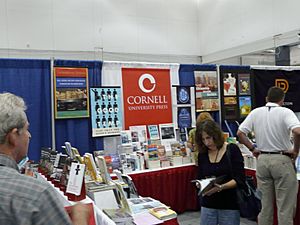Cornell University Press facts for kids
 |
|
| Parent company | Cornell University |
|---|---|
| Founded | 1869 |
| Country of origin | United States |
| Headquarters location | Ithaca, New York, U.S. |
| Distribution | Longleaf Services |
| Publication types | Books |
| Imprints | ILR Press |
The Cornell University Press is the publishing company for Cornell University. Cornell is a very well-known university, part of the Ivy League, located in Ithaca, New York. The Press is currently in a building called Sage House, which used to be the home of Henry William Sage. It was first started in 1869, making it the very first university publishing group in the United States. However, it was not active for a long time, from 1884 to 1930.
Contents
How the Press Started
The Press began in a part of the university that focused on mechanical arts. This was because engineers in the 1800s knew a lot about running the big, steam-powered printing presses. They knew more about these machines than literature professors did!
Students and Printing Work
From the very beginning, the Press offered a special program. Students who already knew how to print could work there. They were paid to help with typesetting and running the machines. These machines printed textbooks, small books, a weekly student newspaper, and official university papers. This was a great way for students to earn money while learning.
What Cornell University Press Publishes Today
Today, the Cornell University Press is one of the biggest university presses in the country. Each year, they publish about 150 new nonfiction books. These books cover many different subjects.
Subjects They Cover
The Press publishes books on topics like how people live in different cultures (anthropology), studies about Asia, and even biological sciences. They also publish books on ancient history (classics), general history, and how people work together in jobs (industrial relations). Other subjects include how to understand books (literary criticism), nature, ideas about life (philosophy), and how governments work (politics). They also publish books on animal health (veterinary science) and women's studies.
How the Press is Funded
For most of its history, the university helped pay for the Press. But now, the Press mostly relies on selling its books to pay for its work.
New Ways of Publishing
In 2010, a group called the Mellon Foundation gave the Press a grant. This money helped them explore new ways to publish important books, especially in subjects that might not sell a lot of copies.
Special Book Series
With this grant, they published a book series called "Signale: Modern German Letters, Cultures, and Thoughts." For this series, they printed only 500 hard copies of each book. If more copies were needed, they could print them as people ordered them. This helps save resources.
Other book series they publish include "Expertise: Cultures and Technologies of Knowledge."
See also
 In Spanish: Cornell University Press para niños
In Spanish: Cornell University Press para niños
- List of English-language book publishing companies
- List of university presses


